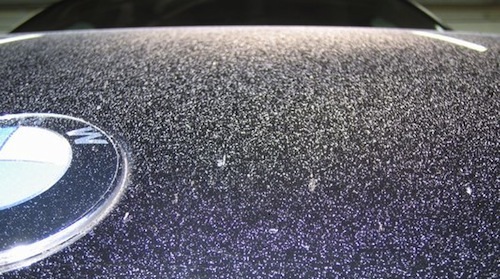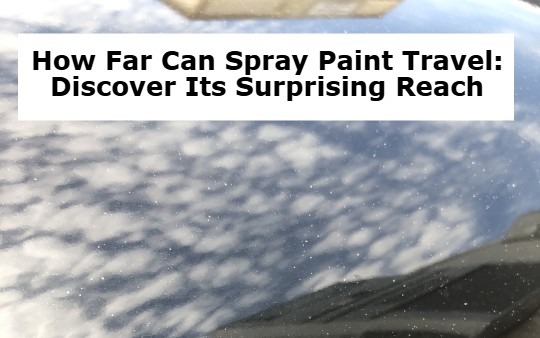Spray paint is a versatile tool used in various applications, from graffiti art to home improvement projects. Understanding how far spray paint can travel is crucial for achieving desired results and avoiding unwanted mess. Factors like wind speed, nozzle type, and spraying technique significantly influence the paint’s reach.
Using a controlled environment and proper equipment helps manage spray distance effectively. This knowledge ensures precise application, whether for artistic or practical purposes, making your spray painting projects more efficient and less wasteful. Keep these considerations in mind to achieve the best results with spray paint.
Introduction To Spray Paint Reach
Spray paint is a versatile tool that can cover surfaces quickly. But have you ever wondered how far it can travel? Understanding spray paint’s reach is essential for both artists and DIY enthusiasts. This knowledge helps achieve better results and avoid unnecessary mess.
What Is Spray Paint?
Spray paint is a type of paint in a sealed pressurized container released in an aerosol spray. It is easy to use and provides a smooth and even finish. It is used for various tasks, including arts and crafts and home improvement.
Importance Of Understanding Reach
Knowing the reach of spray paint is crucial. It helps you plan your project, ensures you apply the paint accurately, prevents overspray and wastage, and protects surrounding areas. Proper understanding of reach leads to better and cleaner results.
| Factors Affecting Reach | Impact |
|---|---|
| Type of Nozzle | It affects spray pattern and distance |
| Pressure in the Can | Higher pressure means farther reach |
| Angle of Spray | Directly impacts the travel distance |
- Wear a mask to avoid inhaling fumes.
- Always test spray on a small area first.
- Keep the can at the right distance for even coverage.

Factors Influencing Spray Paint Travel
Understanding the factors influencing spray paint travel is crucial for any painting project. This knowledge helps ensure a clean and precise application. Let’s explore the main factors that affect how far spray paint can travel.
Weather Conditions
Weather plays a significant role in spray paint travel. Wind, humidity, and temperature are the main weather factors to consider.
- Wind: Wind can carry spray paint particles further than intended. Strong winds may cause overspray, leading to a messy application.
- Humidity: High humidity affects the drying time of spray paint. It can cause paint to travel less efficiently.
- Temperature: Extreme temperatures can affect the viscosity of spray paint. Cold weather makes paint thicker, while hot weather makes it thinner.
Spray Paint Type
The type of spray paint used also impacts its travel distance. Different formulations and nozzle designs influence how far the paint will go.
| Spray Paint Type | Travel Distance |
|---|---|
| Standard Aerosol | Moderate |
| High-Pressure Aerosol | Longer |
| Low-Pressure Aerosol | Shorter |
Nozzle design also affects spray paint travel. A narrow nozzle produces a focused stream, leading to longer travel. A wide nozzle creates a broader spray, resulting in shorter travel.
To ensure effective spray paint application, consider these factors. They will help you achieve the desired results.
Environmental Impact
Spray paint can travel far beyond the initial application site. This spread has significant environmental implications. Understanding these impacts is key to making informed decisions about using spray paint.
Impact On Air Quality
Spray paint releases volatile organic compounds (VOCs) into the air. These chemicals can contribute to air pollution and are harmful to both humans and the environment. VOCs can cause respiratory issues and other health problems. They also contribute to the formation of ground-level ozone, which can lead to smog and poor air quality.
Using spray paint outdoors can affect air quality over a large area. Even indoor use can have consequences if the space is not well-ventilated. To minimize the impact, always use spray paint in well-ventilated areas. Consider using products labeled as low-VOC or VOC-free.
Effect On Surroundings
Spray paint particles can settle on nearby surfaces, including soil, water bodies, and vegetation. These particles can harm plants and animals and contaminate soil and water, affecting local ecosystems.
Birds and small animals can ingest paint particles, leading to poisoning and other health issues. Plants may absorb harmful chemicals through their leaves and roots, affecting their growth and health.
To reduce the environmental impact, always cover nearby areas before spraying. Use tarps or other barriers to contain the spray. This will help protect the surrounding environment from contamination.
Case Studies Of Spray Paint Travel
Understanding how far spray paint can travel is essential for many reasons. It helps in planning graffiti art, industrial projects, and safety measures. This section will explore specific case studies in different environments.
Urban Environments
Spray paint behaves differently in urban settings. Buildings, walls, and narrow streets affect its travel distance. In a city, wind patterns play a significant role. Tall buildings can create wind tunnels. This can make spray paint travel farther than expected.
- Wind Tunnels: Tall buildings create wind tunnels. Spray paint can travel up to 50 feet.
- Obstructions: Walls and cars can block the spray. This limits travel to about 10 feet.
- Temperature: Higher temperatures cause spray paint to dry quickly. This reduces its travel distance.
In urban areas, expect variability in spray paint travel. Environmental factors significantly impact the distance.
Rural Settings
Rural settings offer a different landscape for spray paint travel. Open fields and fewer obstructions mean spray paint can travel farther. Wind speed and direction are crucial here.
- Open Fields: Spray paint can travel up to 100 feet in open areas.
- Wind Speed: High winds can carry spray paint farther. Speeds over 10 mph can extend travel distance.
- Vegetation: Trees and bushes can block spray paint. This reduces travel to about 20 feet.
Rural environments provide more room for spray paint to travel. Wind and vegetation are the primary factors influencing distance.
Safety Precautions
Understanding how far spray paint can travel is essential for safe use. Safety precautions are necessary to avoid accidents and health hazards. This section will guide you through essential safety measures.
Protective Gear
Wearing the right protective gear is crucial when using spray paint. Here’s a list of items you should consider:
- Respirator Mask: Protects your lungs from harmful fumes.
- Safety Goggles: Shields your eyes from paint particles.
- Gloves: Keeps your hands clean and safe.
- Protective Clothing: Wear long sleeves and pants to cover your skin.
Safe Distances
Maintaining a safe distance ensures the spray does not reach unintended areas. Always consider the following:
| Distance | Reason |
|---|---|
| At least 6 feet | To avoid inhaling fumes directly. |
| 10-15 feet | To prevent paint from drifting to nearby objects. |
Keep windows and doors closed to limit paint travel. Ensure you are in a well-ventilated area to disperse fumes.
By following these safety precautions, you can enjoy a safer painting experience. Always prioritize safety to protect yourself and your surroundings.
Technological Advances
Spray paint technology has made incredible advancements, improving precision, range, and environmental impact. Let’s explore some key innovations.
Innovative Spray Nozzles
Modern spray nozzles offer better control and efficiency. They help achieve a more uniform spray pattern, which allows for greater application accuracy.
- Adjustable Nozzles: These let users change the spray width. It ensures better coverage.
- High-Pressure Nozzles: These nozzles can spray paint over longer distances. They are ideal for large surfaces.
- Anti-Drip Features: These nozzles prevent unwanted drips. They help in keeping the work area clean.
With these innovations, spray paint can reach farther and more precisely.
Eco-friendly Formulations
Eco-friendly spray paints are becoming more popular. These formulations reduce environmental impact.
| Feature | Benefit |
|---|---|
| Low VOCs | Reduces harmful emissions. |
| Water-based | Less toxic than solvent-based paints. |
| Recyclable Cans | Minimizes waste. |
These eco-friendly options ensure that painting projects are safer for the environment. The advancements in spray paint technology make it easier to achieve great results.
Diy Projects And Spray Paint Reach
Spray paint is a versatile tool in DIY projects. Knowing how far it can travel is crucial for achieving the best results. Let’s explore its reach in various DIY applications.
Home Improvement Uses
Spray paint can be used for many home improvement tasks. It is great for painting furniture, walls, and outdoor items. The distance spray paint travels depends on the nozzle and pressure. Generally, it can reach up to 6-12 inches. Always test on a small area first.
- Furniture: Chairs, tables, and cabinets.
- Walls: Accent walls and touch-ups.
- Outdoor: Fences, garden decor, and mailboxes.
Ensure you use protective gear and cover surrounding areas. This prevents unwanted paint on other surfaces. Follow the manufacturer’s instructions for the best results.
Artistic Applications
Spray paint is widely used in art projects. Artists use it for murals, stencils, and graffiti. The travel distance of spray paint affects the artwork’s precision.
- Murals: Large-scale paintings on walls.
- Stencils: Creating detailed and repeated patterns.
- Graffiti: Urban art on buildings and other structures.
Use various nozzles for different effects. Fine nozzles provide detailed lines, while wide nozzles cover larger areas quickly. Experiment with distances to achieve unique textures and effects.
| Application | Travel Distance | Best Practices |
|---|---|---|
| Furniture | 6-12 inches | Use even strokes |
| Murals | 6-18 inches | Test different nozzles |
| Stencils | 4-8 inches | Secure stencil firmly |
Spray paint offers endless possibilities. Knowing its reach helps in executing perfect projects.
Frequently Asked Questions
How Far Can Spray Paint Reach?
Depending on wind and nozzle pressure, spray paint can travel up to 10-15 feet. Always use it in a well-ventilated area to avoid inhalation.
What Affects Spray Paint Distance?
Wind, nozzle type, and pressure affect how far spray paint travels. Strong wind can carry paint particles farther.
Can Spray Paint Travel Indoors?
Yes, spray paint can travel indoors. Ensure proper ventilation to avoid inhaling fumes and limit paint spread.
Does Temperature Impact Spray Paint Travel?
Yes, temperature impacts spray paint travel. Warmer temperatures cause paint to dry faster, reducing travel distance.
Conclusion
Understanding how far spray paint can travel helps achieve perfect results. Consider wind, nozzle type, and paint consistency. Always spray in a controlled environment for the best outcomes. This ensures precision and avoids unwanted overspray. Happy painting, and stay creative!
